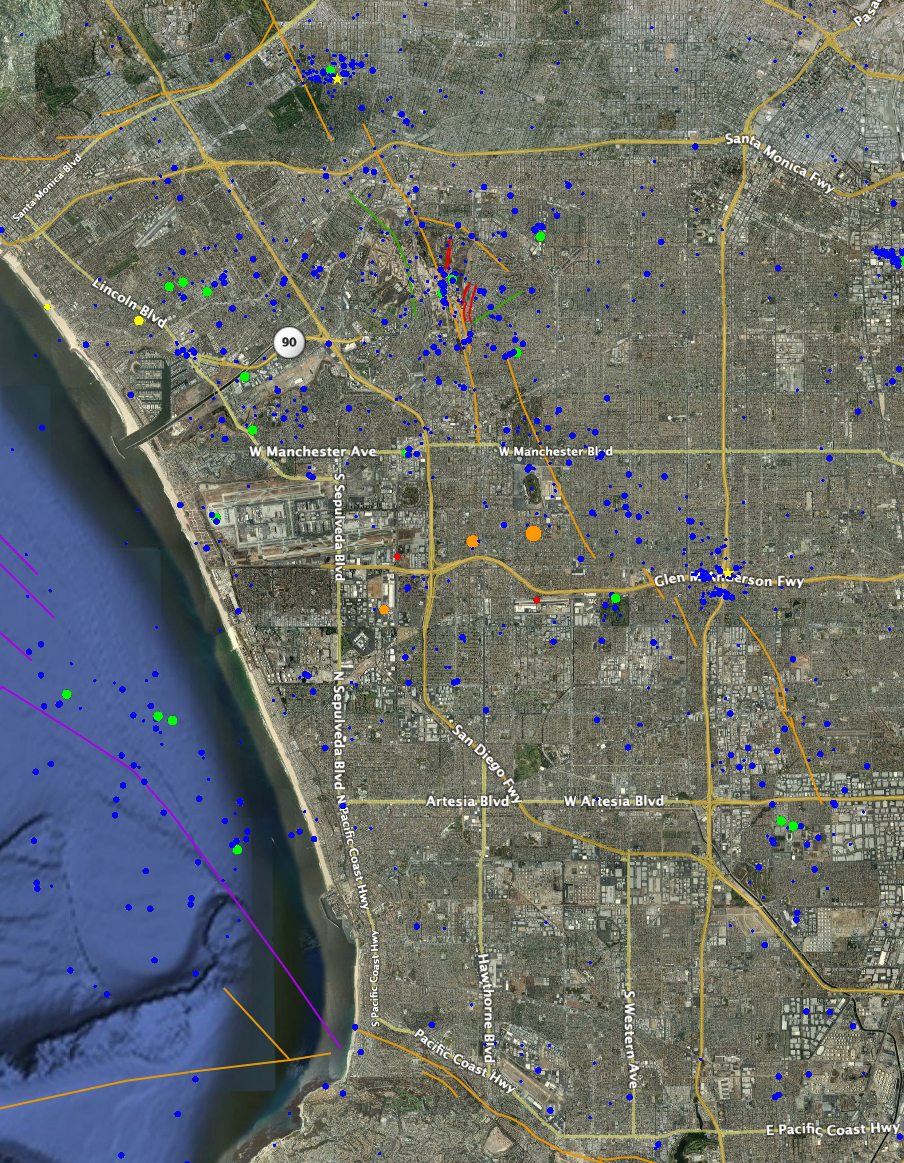Log in to view full website content, join discussions, and to post information.
Inglewood Earthquake; M 4.7 on Sunday, 17 May 2009 at 8:39 p.m. PDT
A magnitude 4.7 earthquake struck in Inglewood, California, about 3 miles east of Los Angeles International airport at 8:39 p.m. (PDT) local time, at a depth of 8.5 miles. Given that the location was in a densely populated part of the Los Angeles basin, it was widely felt. Updated estimates from the USGS ShakeMap and PAGER indicate that although strong shaking was experienced by many people, damage was light. Earthquake shaking was most pronounced in the heart of the Los Angeles basin, with strong shaking (MMI VI, capable of causing light damage) from city center south to Long Beach, and from the coast to Cerritos. The distribution of shaking in the region is shown on the ShakeMap (attached below).
Historical Seismicity map, courtesy of Bob Dollar (USGS): [seismicity 1990-2005, present is orange] - same as distributed in v.4
The focal mechanism is consistent with slip on the Newport-Inglewood fault, which was the source of the damaging 1933 M 6.4 Long Beach earthquake. Aftershocks, however, are west of the Newport-Inglewood fault trend rather than along it. The Los Angeles basin is crossed from northwest to southeast by the intensively studied Newport-Inglewood fault zone. In 1920, the Inglewood earthquake (M 4.9) occurred in nearly the identical location to this evening's earthquake. The 1920 event was the original reason for identification of this as an active fault zone capable of damaging earthquakes, which then later proved to be the case in the 1933 Long Beach event. After the 1933 event, the name of the fault zone was changed to the Newport-Inglewood fault zone in recognition that it is continuous from Beverly Hills to Newport Beach. At this point, the odds of a felt aftershock (M>3) are well below fifty-fifty, and will continue to diminish with time.
Over 40,000 responses have been received to "Did You Feel It" (DYFI) - please report your observations at the DYFI web site listed below. The Did You Feel It map shows an area of strong shaking (MMI=VI) in the vicinity of Compton, and light to moderate shaking (MMI=IV to V) over a broad area. The USGS PAGER results have been updated and the calculated number of people exposed to strong shaking is 890,000. Cities that experienced strong shaking (MMI=VI) include Cudahy, Torrance, Lynewood, Compton, West Compton, Gardena, East Compton, Willowbrook, Alondra Park, Lawndale, Lakewood, and South Gate. Over 3 million people are estimated to have experienced moderate shaking.
USGS 'talking points' - version 5.0; initially distributed at 9:15 a.m.
Thanks to Mike Blanpied and David Schwartz for their comments on earlier versions that helped to clarify and add content, to Dave Wald and Paul Earle and others for ShakeMap and PAGER results, and to Bob Dollar for the figure. Also, big thanks to Sue Hough (Duty Seismologist), Lucy Jones and Egill Hauksson for handling most of the news media pressure here, and Anthony Guarino for timing and SCSN web updates. Thanks to everyone who help! - Ken Hudnut
Links for additional information:
http://earthquake.usgs.gov/eqcenter/recenteqsus/Quakes/ci10410337.php
http://www.scsn.org/
http://earthquake.usgs.gov/eqcenter/
http://www.data.scec.org/fault_index/newping.html
USGS ShakeMap:
http://earthquake.usgs.gov/eqcenter/shakemap/sc/shake/10410337
USGS PAGER:
http://earthquake.usgs.gov/eqcenter/pager/events/ci/10410337/index.html
http://earthquake.usgs.gov/eqcenter/pager/events/ci/10410337/index.html
USGS Did You Feel It?
http://earthquake.usgs.gov/eqcenter/dyfi/events/ci/10410337/us/index.html
Report it here:
http://earthquake.usgs.gov/eqcenter/dyfi/events/ci/10410337/us/index.html
- Login to post comments